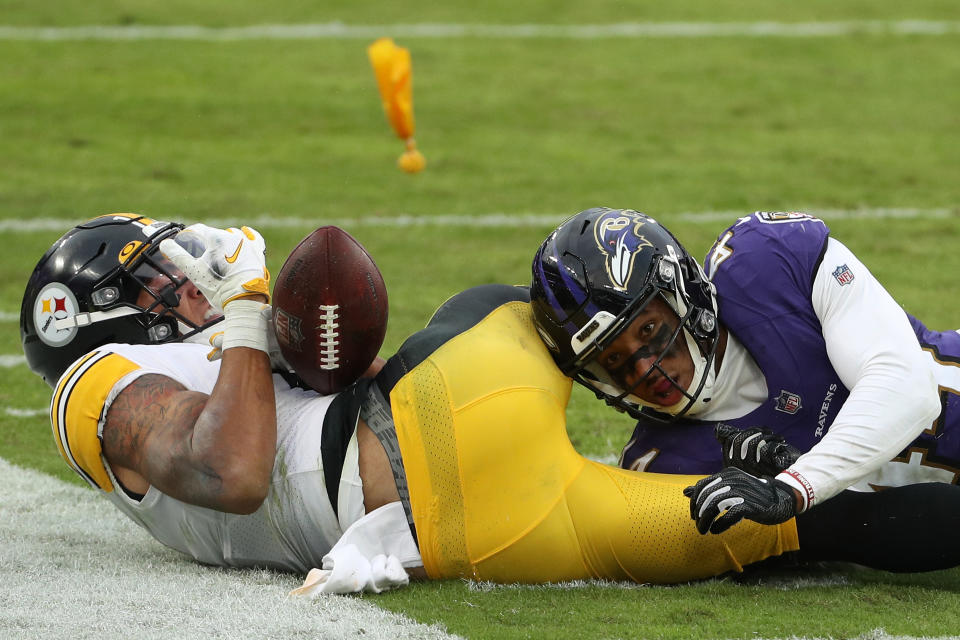The NFL is getting bashed because it strengthened its COVID policy
Marlon Humphrey didn’t know. Neither did AJ Dillon. Neither did we.
On the eighth Sunday of an infinitely strange NFL season, after a week of relative stability, when 10 hours of football kicked into gear, nobody knew anything. Nobody could have known, or even predicted, that two NFL players who played over the weekend did so while COVID-positive.
This is why the news, when it arrived Monday morning, was so perplexing and indigestible. Humphrey, a Baltimore Ravens All-Pro cornerback, and Dillon, a Green Bay Packers rookie running back, had tested positive for the coronavirus.
They learned of the positive results Monday morning.
The results were from tests taken Sunday morning.
In the interim, after the tests, they played 70 combined snaps in their respective games.
The seemingly backward timeline led fans to decry the NFL’s apparent idiocy. And in a way, their incredulity made complete sense. The optics, when laid bare in a punchy headline or tweet, are … not great!
The NFL and NFLPA agreed to game-day PCR testing for COVID-19 starting in Week 6. Everyone tests Sunday morning, but don't get results until late Sunday/early Monday.
So, #Ravens CB Marlon Humphrey and #Packers RB A.J. Dillon played Sunday, only to learn today they're positive.— Tom Pelissero (@TomPelissero) November 2, 2020
They’re also superficial and misleading.
They are, in an ironic twist, byproducts of the notoriously image-conscious NFL prioritizing safety over optics. The league’s protocols aren’t perfect. No COVID-19 countermeasures are. But this apparent oversight is actually the result of the NFL being overprotective, not careless or flat-out dumb.
The NFL tightens its testing window
Consider an alternate scenario. Let’s pretend, for a moment, that Humphrey contracted the coronavirus in Week 4, not Week 8. Let’s say, after contracting it midweek, and after a few-day incubation period, that he became infectious — and capable of testing positive — around 11 p.m. on Saturday.
In Week 4, there would have been no uproar. No NFL-bashing. Because we wouldn’t have even known Humphrey played while COVID-positive
In Week 4, instead, there would have been increased potential for a Titans-esque outbreak.
This is because, prior to Week 6, the NFL didn’t test on gamedays. Its reasoning, essentially, boiled down to optics over safety. It feared false positives — and the possibility of players missing games due to unnecessary caution — more than it feared the possibility of a player actually having the virus and infecting teammates. So, early in the season, it would test on Saturday morning. Results would arrive by Sunday morning. Everybody who tested negative was in the clear. The next round of testing wasn’t until Monday, with results 12-24 hours later.
On that timeline, the Ravens would have learned of Humphrey’s infection Tuesday. Which would have been worrisome, but optically palatable. They wouldn’t have known that Humphrey had been positive on Sunday. They therefore wouldn’t have been criticized. The chief culprit would be the virus itself, not the league trying to cope with it.
Optics, though, don’t change reality. They wouldn’t have changed the fact that Humphrey was COVID-positive on Sunday. Without a Sunday test, the Ravens would have met in person on Monday, as they always do — and Humphrey would have had another full day to potentially expose teammates to the virus.
The NFL learned this the hard way. Monday exposure due to a lack of Sunday testing might have contributed to the Titans’ outbreak. In the aftermath, the league closed its Sunday hole.
What it has known all along, though, and what its fans are now learning, is that closing all holes is impossible.

Impossible to close all windows entirely
There is one semi-legitimate criticism of the NFL’s testing: That on weekends, it isn’t frequent or quick enough. A Sunday early-morning test with a Sunday late-morning result would be preferable. Even a Saturday late-night test with a Sunday pregame result would be slightly better than the current schedule.
But no matter the regimen, the virus’ window of opportunity will exist. The NFL can’t eliminate it. Anytime between the administration of Saturday’s test and the result of Sunday’s test — a window of about 36 hours — a player could become infectious and infect teammates. Even a rapid point-of-care (POC) test administered at 8:15 a.m. Sunday that comes back negative at 8:30 a.m. wouldn’t guarantee that a player is still COVID-negative at 1 p.m.
The NFL’s goal is to minimize those windows. It already does this better than almost any private, non-essential business in the world. Perhaps, you could argue, it should use POC testing league-wide on gameday mornings; but it would likely argue that POC tests are less reliable and sensitive, and therefore might not catch gameday positives anyway. Perhaps, you could argue, it should strong-arm its way to the front of the testing line and ensure Sunday morning results arrive in a matter of hours; but expedited turnarounds are logistically burdensome and, for non-essential operations, morally questionable.
The true alternative to the testing scheme that some fans bashed on Monday is less testing. It’s six days a week instead of seven. It’s what the NFL used to do. And it makes no sense at all. Testing is information. Information is valuable, no matter when it arrives. Refusing to seek out information because it might reveal problems will, in this case, only exacerbate those problems.
Testing on gameday is a choice between fleeting comfort and enhanced safety. And there is only one correct choice — even if a headline or two make the NFL look silly.
More from Yahoo Sports:

 Yahoo Finance
Yahoo Finance 
